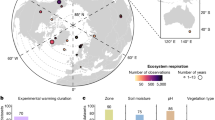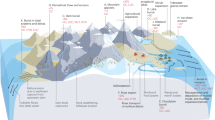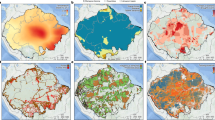Abstract
The onset of the late Palaeozoic ice age about 340 million years ago has been attributed to a decrease in atmospheric CO2 concentrations associated with expansion of land plants, as plants both enhance silicate rock weathering—which consumes CO2—and increase the storage of organic carbon on land. However, plant expansion and carbon uptake substantially predate glaciation. Here we use climate and carbon cycle simulations to investigate the potential effects of the uplift of the equatorial Hercynian mountains and the assembly of Pangaea on the late Palaeozoic carbon cycle. In our simulations, mountain uplift during the Late Carboniferous caused an increase in physical weathering that removed the thick soil cover that had inhibited silicate weathering. The resulting increase in chemical weathering was sufficient to cause atmospheric CO2 concentrations to fall below the levels required to initiate glaciation. During the Permian, the lowering of the mountains led to a re-establishment of thick soils, whilst the assembly of Pangaea promoted arid conditions in continental interiors that were unfavourable for silicate weathering. These changes allowed CO2 concentrations to rise to levels sufficient to terminate the glacial event. Based on our simulations, we suggest that tectonically influenced carbon cycle changes during the late Palaeozoic were sufficient to initiate and terminate the late Palaeozoic ice age.
This is a preview of subscription content, access via your institution
Access options
Access Nature and 54 other Nature Portfolio journals
Get Nature+, our best-value online-access subscription
$29.99 / 30 days
cancel any time
Subscribe to this journal
Receive 12 print issues and online access
$259.00 per year
only $21.58 per issue
Buy this article
- Purchase on Springer Link
- Instant access to full article PDF
Prices may be subject to local taxes which are calculated during checkout



Similar content being viewed by others
References
Montanez, I. P. & Poulsen, C. J. The Late Paleozoic ice age: an evolving paradigm. Annu. Rev. Earth Planet. Sci. 41, 629–656 (2013).
Isbell, J. L. et al. Glacial paradoxes during the late Paleozoic ice age: evaluating the equilibrium line altitude as a control on glaciation. Gondwana Res. 22, 1–19 (2012).
Montanez, I. P. et al. Climate, pCO2 and terrestrial carbon cycle linkages during late Paleozoic glacial–interglacial cycles. Nat. Geosci. 9, 824–828 (2016).
Kump, L. R. & Arthur, M. A. in Tectonic Uplift and Climate Change (ed. Ruddiman, W. F.) 399–426 (Springer, 1997).
Berner, R. A. The Phanerozoic Carbon Cycle (Oxford Univ. Press, 2004).
Bergman, N. M., Lenton, T. M. & Watson, A. J. COPSE: a new model of biogeochemical cycling over Phanerozoic time. Am. J. Sci. 304, 397–437 (2004).
Davies, N. S. & Gibling, M. The sedimentary record of Carboniferous river: continuing influence of land plant evolution on alluvial process and Palaeozoic ecosystems. Earth Sci. Rev. 120, 40–79 (2013).
Nelsen, M. P., Dimichele, W. A., Peters, S. E. & Boyce, C. K. Delayed fungal evolution did not cause the Paleozoic peak in coal production. Proc. Natl Acad. Sci. USA 9, 2442–2447 (2016).
Montanez, I. P. A late Paleozoic climate window of opportunity. Proc. Natl Acad. Sci. USA 113, 2334–2336 (2016).
Stallard, R. F. Relating chemical and physical erosion. Rev. Mineral. 31, 543–564 (1995).
Gabbet, E. J. & Mudd, S. M. A theoretical model coupling chemical weathering rates with denudation rates. Geology 37, 151–154 (2009).
Hilley, G. E., Chamberlain, C. P., Moon, S., Porder, S. & Willet, S. D. Competition between erosion and reaction kinetics in controlling silicate-weathering rates. Earth Planet. Sci. Lett. 293, 191–199 (2010).
Carretier, S., Godderis, Y., Delannoy, T. & Rouby, D. Mean bedrock-to-saprolite conversion and erosion rates during mountain growth and decline. Geomorphology 209, 39–52 (2014).
Donnadieu, Y. et al. A GEOCLIM simulation of climatic and biogeochemical consequences of Pangea breakup. Geochem. Geophys. Geosyst. 7, Q11019 (2006).
Godderis, Y., Donnadieu, Y., Le Hir, G., Lefebvre, V. & Nardin, E. The role of palaeogeography in the Phanerozoic history of atmospheric CO2 and climate. Earth-Sci. Rev. 128, 122–138 (2014).
Oliva, P., Viers, J. & Dupré, B. Chemical weathering in granitic crystalline environments. Chem. Geol. 202, 225–256 (2003).
Donnadieu, Y., Puceat, E., Moiroud, M., Guillocheau, F. & Deconinck, J. F. A better-ventilated ocean triggered by Late Cretaceous changes in continental configuration. Nat. Commun. 7, 10316 (2016).
Godderis, Y., Donnadieu, Y., Tombozafy, M. & Dessert, C. Shield effect on continental weathering: implication for climatic evolution of the Earth at the geological timescale. Geoderma 145, 439–448 (2008).
Stallard, R. F. & Edmond, J. M. Geochemistry of the Amazon: 3. Weathering chemistry and limits to dissolved inputs. J. Geophys. Res. 92, 8293–8302 (1987).
Strudley, M., Murray, A. & Haff, P. Emergence of pediments, tors, and piedmont junction from a bedrock weathering-regolith thickness feedback. Geology 34, 805–808 (2006).
West, J. A. Thickness of the chemical weathering zone and implications for erosional and climatic drivers of weathering and for carbon-cycle feedbacks. Geology 40, 811–814 (2012).
Golonka, J. in Phanerozoic Reef Patterns Vol. 72 (eds Kiessling, W., Flügel, E. & Golonka, J.) 21–75 (SEPM Special Publications, 2002).
Royer, D. L. in The Atmopshere History Vol. 6 (ed. Farquhar, J.) 251–267 (Elsevier, 2014).
Tabor, N. J. & Poulsen, C. J. Paleoclimate across the Late Pennsylvanian–Early Permian tropical paleolatitudes: a review of climate indicators, their distribution, and relation to paleophysiographic climate factors. Palaeogeogr. Palaeoclimatol. Palaeoecol. 268, 293–310 (2008).
Lowry, D. P., Poulsen, C. J., Horton, D. E., Torsvik, T. & Pollard, D. Thresholds for Paleozoic ice sheet initiation. Geology 42, 627–630 (2014).
Goddéris, Y. & François, L. M. The Cenozoic evolution of the strontium and carbon cycles: relative importance of continental erosion and mantle exchanges. Chem. Geol. 126, 169–190 (1995).
Galy, A., France-Lanord, C. & Derry, L. A. The strontium isotopic budget of Himalayan rivers in Nepal and Bangladesh. Geochem. Cosmochim. Acta 63, 1905–1925 (2002).
Li, G. & Elderfield, H. Evolution of carbon cycle over the past 100 million years. Geochem. Cosmochim. Acta 103, 11–25 (2013).
Millot, R., Gaillardet, J., Dupré, B. & Allègre, C. J. The global control of silicate weathering rates and the coupling with physical erosion: new insights from rivers of the Canadian Shield. Earth Planet. Sci. Lett. 196, 83–98 (2002).
West, A., Galy, A. & Bickle, M. Tectonic and climatic controls on silicate weathering. Earth Planet. Sci. Lett. 235, 211–228 (2005).
Galy, V. et al. Efficient organic carbon burial in the Bengal fan sustained by the Himalayan erosional system. Nature 450, 407–410 (2007).
Galy, V., Peucker-Ehrenbrink, B. & Eglinton, T. Global carbon export from the terrestrial biosphere controlled by erosion. Nature 521, 204–207 (2015).
Veizer, J. et al. 87Sr/86Sr, δ13C and δ18O evolution of Phanerozoic seawater. Chem. Geol. 161, 59–88 (1999).
Royer, D. in Treatise on Geochemistry Vol. 6 (eds Holland, H. D. & Turekian, K. K.) 251–267 (Elsevier, 2014).
Francois, L. M. & Godderis, Y. Isotopic constraints on the Cenozoic evolution of the carbon cycle. Chem. Geol. 145, 177–212 (1998).
Kump, L. R. & Arthur, M. A. Interpreting carbon-isotope excursions: carbonates and organic matter. Chem. Geol. 161, 181–198 (1999).
Berner, R. A., Lasaga, A. C. & Garrels, R. M. The carbonate–silicate geochemical cycle an its effects on atmospheric carbon dioxide over the past 100 million years. Am. J. Sci. 284, 641–683 (1983).
Walker, J. C. G., Hays, P. B. & Kasting, J. F. A negative feedback mechanism for the long-term stabilization of Earth’s surface temperature. J. Geophys. Res. 86, 9776–9782 (1981).
Berner, R. A. & Caldeira, K. The need for mass balance and feedback in the geochemical carbon cycle. Geology 25, 955 (1997).
Zeebe, R. & Caldeira, K. Close mass balance of long-term carbon fluxes from ice-core CO2 and ocean chemistry records. Nat. Geosci. 1, 312–315 (2008).
Jacob, R. L. Low Frequency Variability in a Simulated Atmosphere Ocean System PhD thesis, Univ. Winsconsin (1997).
Pierrehumbert, R. T. High levels of atmospheric carbon dioxide necessary for the termination of global glaciation. Nature 429, 646–649 (2004).
Lefebvre, V., Donnadieu, Y., Sepulchre, P., Swingedouw, D. & Zhang, Z. S. Deciphering the role of southern gateways and carbon dioxide on the onset of the Antarctic Circumpolar Current. Paleoceanography 27, PA002345 (2012).
Gough, D. O. Solar interior structure and luminosity variations. Sol. Phys. 74, 21–34 (1981).
Gaillardet, J., Dupré, B., Louvat, P. & Allègre, C. J. Global silicate weathering and CO2 consumption rates deduced from the chemistry of the large rivers. Chem. Geol. 159, 3–30 (1999).
Dessert, C., Dupre, B., Gaillardet, J., Francois, L. M. & Allegre, C. J. Basalt weathering laws and the impact of basalt weathering on the global carbon cycle. Chem. Geol. 202, 257–273 (2003).
Whipple, K. X. & Tucker, G. E. Dynamics of the stream-power river incision model: implications for height limits of mountain ranges, landscapes response timescales, and research needs. J. Geophys. Res. 104, 17661–17674 (1999).
Heimsath, A. M., Hancock, G. R. & Fink, D. The ‘humped’ soil production function: eroding Arnhem Land, Australia. Earth Surf. Process. Landf. 34, 1674–1684 (2009).
Gilbert, G. K. Report on the Geology of the Henry Mountains (Utah) (Department of the Interior, 1877).
Norton, K. P., Molnar, P. & Schlunegger, F. The role of climate-driven chemical weathering on soil production. Geomorphology 204, 510–517 (2014).
Gabet, E. J. & Mudd, S. M. Bedrock erosion by root fracture and tree throw: a coupled biogeomorphic model to explore the humped soil production function and the persistence of hillslope soils. J. Geophys. Res. 115, F04005 (2010).
Syvitski, J. P. M., Peckham, S. D., Hilberman, R. & Mulder, T. Predicting the terrestrial flux of sediment to the global ocean: a planetary perspective. Sedim. Geol. 162, 5–24 (2003).
Farr, T. G. et al. The shuttle radar topography mission. Rev. Geophys. 45, RG2004 (2007).
Acknowledgements
CNRS INSU/SYSTER program and the ANR projects TERRES and Anox-Sea have provided funding for this work. We thank the CEA/CCRT for providing access to the HPC resources of TGCC under the allocation 2015–012212 made by GENCI.
Author information
Authors and Affiliations
Contributions
Y.G. and Y.D. conceived the study and wrote the paper with contributions from all co-authors. The physical erosion model was developed by Y.G., S.C. and Y.D.; Y.G. and Y.D. performed the simulations. G.D., M.A., M.M. and V.R. reconstructed the palaeogeographic settings of the late Palaeozoic (five maps).
Corresponding authors
Ethics declarations
Competing interests
The authors declare no competing financial interests.
Supplementary information
Supplementary Information
Supplementary Information (PDF 6154 kb)
Rights and permissions
About this article
Cite this article
Goddéris, Y., Donnadieu, Y., Carretier, S. et al. Onset and ending of the late Palaeozoic ice age triggered by tectonically paced rock weathering. Nature Geosci 10, 382–386 (2017). https://doi.org/10.1038/ngeo2931
Received:
Accepted:
Published:
Issue Date:
DOI: https://doi.org/10.1038/ngeo2931
This article is cited by
-
Climate extremes likely to drive land mammal extinction during next supercontinent assembly
Nature Geoscience (2023)
-
Deconstructing plate tectonic reconstructions
Nature Reviews Earth & Environment (2023)
-
Diverse carbon dioxide removal approaches could reduce impacts on the energy–water–land system
Nature Climate Change (2023)
-
Andean-type orogenic plateau as a trigger for aridification in the arcs of northeast Pangaea
Communications Earth & Environment (2023)
-
Phanerozoic oceanic and climatic perturbations in the context of Tethyan evolution
Science China Earth Sciences (2023)



